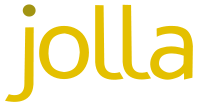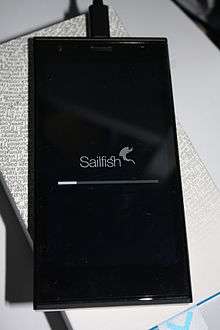Jolla
 | |
|
Osakeyhtiö (Limited company) | |
| Industry | Mobile devices, Consumer Electronics/Devices |
| Predecessor | MeeGo team from Nokia |
| Founded | Pirkkala, Finland (March 29, 2011) |
| Founder |
|
| Headquarters | Helsinki, Finland |
Area served | Worldwide |
Key people | |
| Products | Smartphones with Linux-based Sailfish OS continuing the previous work of the MeeGo project |
Number of employees | 150 developers |
| Website |
jolla |
Jolla Oy[1] (sometimes referred to as Jolla Ltd.) is a Finnish technology company; a vendor of mobile devices[2] and the developer of Sailfish OS.[3] Headquartered in Helsinki, Finland, Jolla has its own research and development offices in Helsinki, Tampere and Cyberport, Hong Kong. Jolla was founded in 2011 by former Nokia staff of the MeeGo project team to utilise the MeeGo opportunities and its "endless possibilities".
Pronounced 'yolla', the company name is Finnish for dinghy (a small agile boat or life rescue boat). It was intended as an ironic joke about the "burning platform memo" which contained the metaphor to "jump into the cold sea water" or "burn with burning platform" used in context of the Nokia business activities, in the memo leaked by then-Nokia CEO Stephen Elop in February 2011, with Osborne effect-like consequences.[4]
History

In 2005, Nokia created a new Linux operating system called OS2005, which shipped with the Nokia 770 Internet Tablet. It was renamed Maemo (version 5) and shipped with the Nokia N900 in 2009. An alliance Nokia and Intel merged their Maemo and Moblin (also an open source Linux OS) projects, respectively, into a new project called MeeGo in 2010. Nokia announced that year that the N8 would be the last flagship phone to run Symbian, and "Going forward, N-series devices will be based on MeeGo".[5]
But unexpectedly in 2011 the MeeGo project was declared cancelled no matter whether MeeGo would or wouldn't achieve any success. In compliance with agreements with Intel, only one MeeGo device was released, the Nokia N9, which achieved iconic status.
Despite the N9 market success the MeeGo project in Nokia was already sentenced and a general atmosphere around it was having more and more negative influence on the MeeGo team and other Nokia employees. As a result, in October 2011, some of the MeeGo team left Nokia to form new project of Jolla aimed to develop new opportunities created with the Linux MeeGo OS, using funding from Nokia's "Bridge" program which helps establish and support start-up companies by ex-Nokia employees.[6][7][8]
Nokia at that time was supporting almost all employees leaving the company with €25,000, but Jolla's founders had not been given any rights to patents or other intellectual property to Jolla. Jolla's Sailfish OS, which used middleware core stack of Mer is a direct successor to Nokia and Intel's MeeGo and the Jolla (mobile phone) is successor of N9, however used only the open-sourced components of MeeGo, while the closed-source user interface design (of codename Harmattan) for all future devices had to be developed from scratch. As a result, new mobile standards were established together with Mer.
Jolla went public on 6 July 2012, announcing its intention to develop new smartphones that used a gesture-oriented swipe interface corresponding to former Nokia's Harmattan UI experience. They named their operating system "Sailfish", which is a result of Mer and includes a gesture-based user interface developed using the Qt, QML and HTML5, as did Nokia's N9.
Jolla cooperated with others to grow their application's and MeeGo ecosystem.[9] Jolla announced on 17 September 2013 that their phone will be capable of running Android applications, thanks to built in Alien Dalvik, though due to formal limitation direct access to Google Play Store needed to be installed by end user manually.[10]
On 7 July 2015, after failure of cooperation with Chinese manufacturer on delivery of Jolla Tablet, Jolla announced it would spin out its hardware operations to a brand new company and will continue to focus on current activities as a developer and licensor of the Sailfish OS.[11]
In November 2015, Jolla had to lay off half of its employees due to financial problems caused by delayed financing from investor. On December 21, 2015, after enforced cancelling of Jolla Tablet project, Jolla announced that they would be "shipping a small batch of the Jolla Tablet to early backers during early 2016" which were disposable but "all of our backers will not get a Jolla Tablet"[12] because Chinese manufacturer has sold already produced batch in consequence of delayed financing and it was impossible to produce any next one as essential components were not produced any more.
Products
Hardware

- Jolla Mobile Phone - smartphone with 4.5in IPS qHD display, 16 GB storage, 1 GB RAM, a microSD slot and an 8 MP camera.
- Jolla Tablet - Sailfish OS 2.0 64-bit Intel's CPU tablet with 7.85 in IPS display, 32GB storage, 2GB RAM, Micro SD slot, 5MP main and 2MP front camera
- The Other Half - replaceable back cover to the Jolla phone, which can be used as hardware extension for various purposes. It has NFC and power connection to main smartphone, can have own RAM, CPU, software or hardware, can influence smartphone performance as easy replaceable accessory or extension, e.g. change appearance and ambience settings, or connect the hardware keyboard.
- Jolla C Mobile Phone - smartphone with 5.0in IPS HD display, 16 GB storage, 2 GB RAM, a microSD slot and an 8 MP camera.[14]
Ecosystem
One of elements of the ecosystem is the harbour.jolla.com site, which is devoted to submitting, managing and selling applications at the Jolla Store. Consumers can install available software directly on their Sailfish devices.
Software can be submitted on a free or commercial basis, using either the Sailfish OS or Android OS applications.
The Jolla Harbour and Jolla Store support only free applications. The subsystem for payments is under active development to avoid problems with monetizing software.
For developers and software enthusiasts, sailfishos.org[15] collects and publishes an online compendium of knowledge, links and instructions on:
- software porting and migration to Sailfish OS;
- similarities and differences between Harmattan and Sailfish;
- guides on how to port MeeGo 1.2 Harmattan applications for both the Nokia N9 and the Sailfish operating system;
- porting framework;
- application porting tutorials and examples (QtQuick QML applications, the Flickr Qt 5, SDL / OpenGL ES applications);
- Qt Quick Components map to Sailfish Silica.
Software
Sailfish OS is able to run:
- Sailfish-native apps;
- Android apps using built in Sailfish OS compatibility layer the Alien Dalvik from Myriad Group;
- MeeGo-native apps if its user's interface is usable under Sailfish interface;
- in general all Linux apps compiled for Sailfish device or binaries with RPM storage standard, also in console mode or as a non-graphic terminal.
All Android software available from the Jolla "harbour" store were tested with a real Jolla device. Android or MeeGo or Linux software can be downloaded from any 3rd party e.g. Google store or any other source, due to Sailfish OS openness policy. From launch, this has given the devices access to a large number of applications, which was estimated above 0.5M unique software pieces at the time of the device launch.
Because Sailfish is Linux and use Qt and Sailfish SDK is in Qt, it is possible to port applications without significant effort, including the following sources:
- Qt (ported from other Qt-supported operating systems such as Symbian, Maemo, MeeGo, Windows and other projects with Qt source code)
- MeeGo (because Sailfish has inherited much of the MeeGo work using the MER core)
- Unix and Linux (usually command-line applications or other UI limitations are possible, RPM makes downloading easier)
- HTML5 (using the installed Mozilla-based browser or directly the OS implementation of HTML5)
- Android (either porting to be a Sailfish-native app or with corrections needed for UI)
For easy development and porting the Sailfish SDK emulates the whole device, the whole OS and its behaviour using isolated virtual machine on host computer e.g. Windows or Mac or Linux. As it is fully emulated, not simulated, and Jolla strongly declares it is possible to test behaviour like with real device when using Jolla SDK developer's environment. So it is possible to develop and test software without using a Jolla device. The SDK is updated for free adequately to the OS development. Also its documentation and tutorials/examples which are prepared together with community and developers requests.
See also
- Jolla C
- MeeGo
- Sailfish Alliance - the alliance of companies involved in Sailfish OS
- Aqua Fish
- Liquidmorphium Turing Phone
- PuzzlePhone
- mi-Fone (mobile)
- Oysters SF advanced Sailfish smartphone
- HMD global
References
- ↑ "Jolla Oy", Business Information System, the Finnish National Board of Patents and Registration, and the Finnish Tax Administration, retrieved July 18, 2012
- ↑ JollaSuomi (21 November 2012). "Jolla's Sailfish OS is also for tablets and smart TV's. ;)" (Tweet). Retrieved 2013-07-10 – via Twitter.
- ↑ Jolla at LinkedIn. "LinkedIn". LinkedIn. LinkedIn. Retrieved 10 November 2013.
- ↑ Zieler, Chris. "Nokia CEO Stephen Elop rallies troops in brutally honest 'burning platform' memo? (update: it's real!)". engadget.com. Retrieved 10 December 2012.
- ↑ http://www.cnet.com/news/nokia-picks-meego-over-symbian-for-iphone-rival/
- ↑ "Many former Nokia employees start businesses of their own", Helsingin Sanomat
- ↑ Lunden, Ingrid. "Nokia Bridge: Nokia's Incubator Gives Departing Employees €25k And More To Pursue Ideas That Nokia Has Not". techcrunch.com. techcrunch.com. Retrieved 7 June 2013.
- ↑ Tung, Liam. "Inside Nokia Bridge: How Nokia funds ex-employees' new start-ups". zdnet.com. © 2013 CBS Interactive. Retrieved 7 June 2013.
- ↑ Davies, Chris. "Jolla Mobile CEO: "MeeGo is not dead"". slashgear.com. SlashGear. Retrieved 19 August 2012.
- ↑ "Jolla Sailfish OS Andriod Support". The Register. Retrieved 15 December 2013.
- ↑ "Mobile Maker Jolla Splits In Two, With Sailfish OS Its First Order Of Business". TechCrunch. Retrieved 8 July 2015.
- ↑ "New Year's Greetings from Jolla".
- ↑ "MoMo Helsinki – May 20th – Featuring Jolla Love Day". Mobile Monday. Retrieved 2014-02-18.
- ↑ https://jolla.com/jollac
- ↑ "Porting/Harmattan". SailfishOS. Retrieved 2014-02-18.
External links
- Official website
- Jolla smartfon prototype and Sailfish OS presentation by Chief Designer Martin Schüle, 2013
- Sailfish OS wiki - almost everything about the Sailfish OS and related subjects
- FAQ about Jolla & Sailfish OS